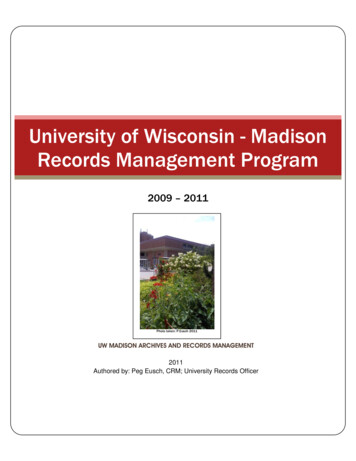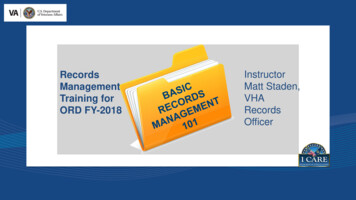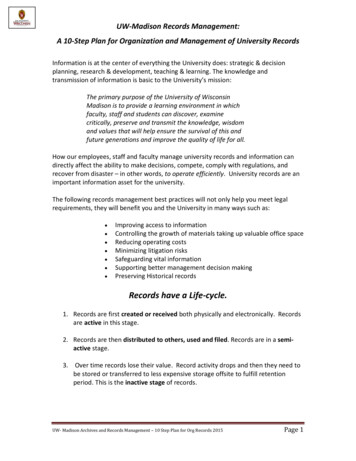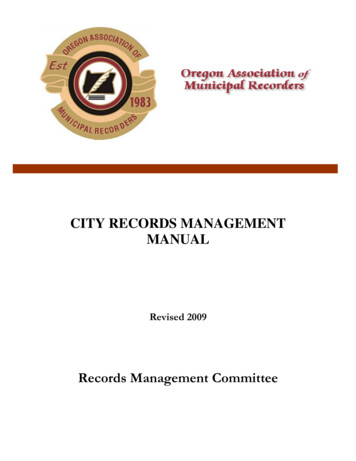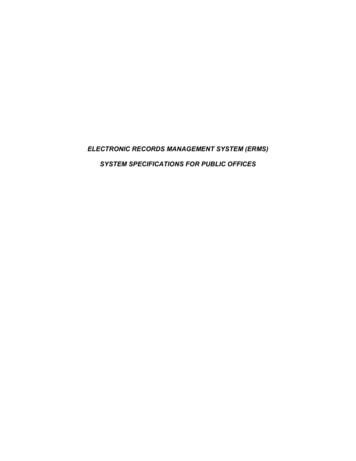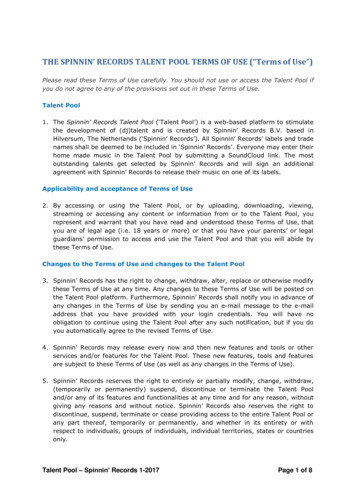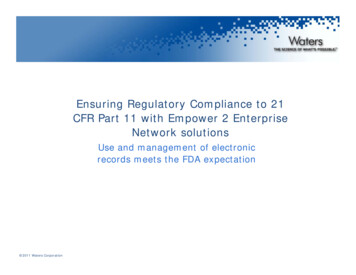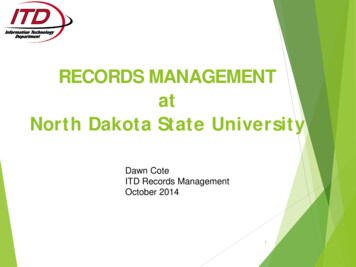
Transcription
RECORDS MANAGEMENTatNorth Dakota State UniversityDawn CoteITD Records ManagementOctober 20141
OverviewDefinitions Importance of Records Management Roles and responsibilities Records retention schedules Annual records disposals Process for changes to the retentionschedules Electronic records/email 2
Is Managing Records a Concern for You?(Top 10 Reasons you Need RM)10. Running out of space9. Can’t fit your fingers in your file drawers8. Lots of misfiles – can’t find anything7. Electronic records were supposed to help butnow have proliferated the problem becausewe print everything we need to keep6. Our storage room is being renovated and ourrecords are thrown in the basement, awarehouse, loft, a garage, or some other nonclimate controlled, rodent infested, waterprone area.3
Top 10 reasons you need RM (cont’d)5. We’re being sued and the lawyers told us to haltdestruction and turn everything over to them fordiscovery.4. My boss told me to hang on to everythingindefinitely just in case 3. The Auditors came and told us we had toimplement ‘a standard record-keeping system’.2. According to new regulations (SOX, ISO 15489,HIPAA, Civil Rules of Procedure, etc.), I need tohave a (or improve my existing) records program.And the #1 reason We had a fire and didn’t protectany of our vital records now we have to go out ofbusiness (or real situation lost student files, nowcan’t prove who went to school there ).4
Not important untilsomething happens Fire, flood, lawsuit, have to recreatesomething Fire: Northern States Power – Feb 1991 (Schwab Corp)Water damage after fire: Courthouse in Missouri (Missouri Archives)5
Why is Having a RIM ProgramImportant to NDSU? SBHE Policy 1912-Public Records Applies to all records of State Board of Higher Education, ND UniversitySystem, and its institutions follow NDCC 44-04-18NDUS 1901.4 Imaging Procedures The purpose of this procedure is to establish an imaging procedure for allNDUS institutions that create, use, and manage digital images Annual reviews of existing policies must be made to ensure recordmaintenance, safety, and authenticity has been met to comply withHIPAA, FERPA, GLBA and privacy lawsNDSU Policy 713 – Records NDSU Task Force will be reviewing and updating Ensure follow state and federal statutes/requirements Without a Records Program, you miss out on Risk Managementdiscount Per SFN 53424 Risk Management Fund–Discount Program Application In order to work, need everyone to follow Bottom line: Good business practices make for better efficiencies6
NDCC 54-46:Records Management Outlines requirements for a standard RecordsManagement Program Includes definitions, duties, and guidelines formanagement, categorization, retention, disposal, andpreservation of records (in all formats). Defined: The systematic control of recordsthroughout their lifecycle (from creation/receipt tofinal disposition).6Primary Goal of Records Management:To provide accurate information, to the right individuals, in the7appropriate format, at the right time, in the most efficientmanner,followed by proper disposal or archival transfer.
Many Areas of Records andInformation Management (RIM)8
RolesNDSU President’s Cabinet – topmanagement support imperative NDSU Records Liaison (between ITD andNDSU) – Director of Records Management NDSU Unit Records Coordinators –Represent each unit at NDSU NDSU Archivist – Collects, administers,preserves historical records ITD Records Management – Education,follow-through on programimplementation, consulting, etc. 9
Records Management ProgramResponsibilities NDSU Records Management Task Force: Ensure policies/procedures/forms related to RM kept current Review proposed updates to retention schedules Key contacts for RM program implementation/changes Communications and trainingUnit Records Coordinators: Follow records retention schedule and submit changes toDirector of Records Management Ensure disposals completed and volumes reported (on behalf ofall employees in their units) Communicate retention schedule updates to all unit employeesAll Employees Review records annually and dispose accordingly Report new/discontinued programs to Unit Records Coordinator Follow established procedures when disposing of records,according to disposal reports (i.e. shred confidential records or10transfer to the NDSU Archives, if historical).
Who is Responsible forManaging Records?Each and everyone of us !!!11
What is a Record? NDCC 54-46-02 defines: “A document, book, paper, photograph,sound recording or other material, regardless of physical form orcharacteristics, made or received pursuant to law or in connectionwith the transaction of official business.” Basically, anything that documents what you do, regardless of physical form orcharacteristics (electronic, paper, etc.)Have tool (flow diagram) to help analyze whether a document is arecord (available on ITD Records Management website): Your office created it. Your office received it and acted on it (i.e. corrective action for an audit). Your office is designated as the custodian/record-holder (accounting files). Your office needs it to document decisions (Board meeting minutes).EXAMPLES: Meeting minutes, accounting files,budget files, correspondence, personnel files,insurance policies, contracts, project files,student files, research documents, etc.12
Why are Records Important? Provides proof of existence, activities, processes Documents compliance (fiscal/financial, legal,confidential and administrative day-to-dayrequirements) Provides litigation and audit support Decision-making Identify and protect essential records (those neededduring of after an emergency/disaster) Preserves institutional memory and provides ahistorical reference to the past (archivalrequirements) When individuals leave – knowledge managementArchival value – preserved for historical reasons(NDCC 55-02.1-05 designates the State HistoricalSociety, or Designee (i.e. NDSU) as depository for allarchival resources.13
What is Not A Record? Library and museum material made or acquiredand preserved solely for reference or exhibitionpurposes. Stocks of publications (i.e. forms, brochures) Rough drafts Tapes – throw/overwrite once transcribed intofinal format Exception: Executive/Confidential portion of meetings - keep for 6 monthsExtra copies of documents retained only forconvenience of reference.NOTE: Identify Originating Organization.Reference copies should NOT be kept longerthan the record.14
How long should records be kept? Not at all One day/month/year One hundred years Lifetime (life of equipment, building,person) One thousand years PermanentPermanent (misconception that permanent indefinite and lifetime).15
What is a RecordsRetention Schedule? List by record series (a group of logicallyrelated records with the same retentionand disposition value - i.e. accountingfiles, project files, personnel records,etc.) Indicates the retention period (length oftime you retain the record series). Indicates the disposal method (landfill,shred, or archival transfer).16
Why a Records RetentionSchedule is Needed To assist in the determination of whatshould be retained vs. disposed (in aconsistent manner).To restrict your filing equipment/space tohouse only “active” records for quickerretrieval – leads to gained efficiencies.To ensure records of enduring value andhistoric interest are properly maintainedand available.To legally destroy records that have servedtheir usefulness.“Follow, defend, and support your planned, written, andlegal retention schedule, and in litigation it will follow,defend, and support you.”
Records Retention Schedules Currently: only one for NDSU (based on UNDs) needs updating (Task Force with input from Unit RCs)Near Future:1. One for records common to all Higher Education institutions,which falls under ND University Systems (General RecordsSchedule for all ND Colleges/Universities): Accounting records Administrative records - gifts/donations, agendas/minutes, bylaws,general correspondence, accreditation, public relations Athletic files - recruitment, eligibility Employee/HR files Legal – contracts, agreements, litigation Safety/Security – incidents, insurance policies Student files – applications, academic records2. One for NDSU (records unique to NDSU-agriculture, research,etc.)18
Records Retention Schedulesavailable on the WebLINK: f (also in brochure)
Annual Disposals:What is the Process? Annual records disposal process: ITDsends disposal packets to Director of RecordsManagement annually Packet includes annual disposal report and certification form Director notifies Unit Records Coordinators of disposal process Unit Records Coordinators communicate disposal process to theirunits Physical disposals completed Unit Records Coordinators return their unit’s records disposalpaperwork to Director of Records Management by May 15 This process will be covered in more detail in a tutorial at alater time (information will be communicated on website andthrough listserv)Director submits cumulative NDSU report to ITD
Records Disposal Packet-Helpful Tools Packet e-mailed to Director of Records Management for distribution to allUnit Record Coordinators, and includes:Instructions, including a link to the retention schedules on the web &retention period abbreviations. Records Disposal Report(s)-NDSU (see below), and the General RecordsSchedule for ALL colleges/universities)-sorted by RCN - Note: Dispose of each record series that has met its retention requirement – complying with thepre-calculated disposal date and method listed.- Further descriptions of each record series are available on the web. Deadline and criteria for what is to be returned to the Director21
Record Control Numbers –grouped by ‘like’ categories 01 (ACT) Accounting 0102Audits 0104Budgets 0115Accounts Payable 0118AccountsReceivableNOTE:RecordsControlNumbers are made up of the first 4digits from the Classification System, then a unique assignednumber for the last 2 digits (i.e. 010201).05 (AF)Agency Federal 10 (AS)Agency State 22 (C/M) Committees/Meetings 35 (ED/T) Education/Training 60Mayrequireinput from Unit Record Coordinators (PER)Personnel 65(P/P) addingPolicies/Procedureswhennew record series to retention 80(SPS) Programs, Projects and Servicesschedules 90 (S/S/R) Survey/Study/Report nd-subject22classification-system.pdf
Form the Director is to submit to ITD23
Disposal Considerations Shredding Usedto destroy confidential (restricted) records Can use licensed and bonded external service Proof Validate of licensure recommended (i.e. Certification)destruction process – stay involvedLandfill/Recycling Disposein trash or recycling container No special protections required Archives Onlysend records identified as historical/archivaland have met the retention timeframe on theretention schedule (not a dumping ground) Make arrangements with NDSU Archives for pickup24
NDSU Archives Thereare 40 record series in theNDSU Records Retention Schedule thatgo to the NDSU Archives Examples:annual reports, executivecorrespondence, publications, grant proposals,program evaluations, accreditation reports,meeting minutes Forarchival transfers, contact theNDSU Archives at 231-8877 Complete NDSU University ArchivesRecords Transmittal/Inventory form(available on NDSU Archives website)23
Keeping Retention SchedulesCurrent Unit Records Coordinators submit requestsfor changes to the Director of RecordsManagement Changes such as: changes to retention timeframes,titles/descriptions, confidential requirements, or adds/deletesdue to new or obsolete programs Use Record Series Description form (SFN 2042) available on thestate e-forms website: http://www.nd.gov/eforms (under ITDInternal) for all modifications Complete the form Adds/Changes: entire form, including what the change is in thedescription area, the confidential requirements (whether changing ornot), Administrative Retention Period, which is in lower left corner, etc. Deletes: only top section (including reason for delete) For all, sign under “Prepared By,” include Telephone Number and DateSubmit to Director of Records Management24
For deletes, onlycomplete the topsection of the form,xxxFor adds or changesindicating reasoncomplete entirefor deletion in theDelete record series – i.e. Program no longer existsform, includingDescription field,Administrativeand sign and dateretention periodat the bottom(recommendation(Prepared By field).from your agency).10 years
Finalizing the Records SeriesDescription (SFN 2042) form Director will review/sign off on form prior tosubmitting to ITD Records ManagementThe form will be routed through the State RMTask Force for review Attorney General – Legal value State Auditor – Audit value State Archivist – Archival value NDSU Archivist – historical interest specific to NDSU State Records Administrator – final retentionApproved changes are posted to website andnotifications madeChanges will be reflected on the following year’sannual disposal report28
Electronic Records/EmailHighlights Electronic Records Management Sameretention/disposal rules apply Same filing schema applies to paper andelectronic files Issues/Solutions Email Treatlike correspondence (file/dispose basedon content or subject matter) Just another media/email system not arecord Develop a policy that includes recordsmanagement (disposal, filing, usage, etc.)29
What Are Electronic Records? Defined: “Records that are machine-readable,or in a digitized format” Electronic records can be comprised of text, data, graphics,images, video, or audio information that is created,maintained, modified, or transmitted in digital form by acomputer or some form of technologyComponents Content, layout, intent/purpose of document,access/restrictions (confidential/exempt-only those withneed-to-know), how retrieved (software/hardware-installs,versions, compatibility, etc.), metadata-internal data aboutthe record/document (date created, who created, etc.)Examples: email messages, word processingdocuments, scanned images, web pages,communication tools (voicemail, IM, Wikis, Blogs).
Managing Electronic RecordsFileFormatsRIMImaging/ScanningLong TermPreservationStandardizedFiling NamingEmail PM Business ProcessManagement/WorkflowAnalysisEDMS ElectronicDocument ManagementSystem31
Electronic Records Issues Easily manipulated (legal issue-authenticity)Easily created and copied: Multiple storage devices (hard drives, laptops, networks, flash drives, CDs, etc.) Multiple “originals” in different locations makes disposals complexleft to Originator-out of sight/out of mind) (disposalLack of filing standards (or inconsistentlyfollowing) “Personal” naming conventions (hard to find) Retrieval reliant on factors not always known (date created, who created,document types, etc.).Technology rapidly changingElectronic storage media (CDs, servers, etc.)typically have a relatively short life span, butinformation may be required to be maintainedlonger (may need hardware/software to read).
Electronic Records Issues Security can be an issue Space can be a limiting issue (i.e. emailmailbox limitations) Cost can be a factor (especially if not disposingaccording to retention schedules or savingmultiple copies) Networkcost (purchasing/administering file servers,backups, retrievals/restorations, etc.). Discoveryfor litigation – costs money to pay a lawyerto review unnecessary copies and records that haveexceeded the retention timeframe. Peoplecosts: wasted staff time trying to locaterecords, or recreate records that cannot be found.
Solutions Centralize (i.e. network, not personal harddrives) Oneoriginal/One location Accessible(security) Applyby appropriate personnelretention schedules to all documents Completerecords disposal process –annually, quarterly, or on a regular basis. Lessvolume easier to manage/less costly/more efficient Applydisposals to ALL versions (if printed document,include footer with location of electronic version (ease oftracking/ destruction)
Electronic Records Disposals Electronic versions (i.e. scanned) can beused as the record and paper disposed(as long as no requirements to keeppaper) Thenapply retention timeframe toelectronic records (as would for paper)using approved retention schedules Dispose of electronic records duringannual records disposal processKeep in mind ‘virtual’ files (as well asphysical): Delete cookies, temp files, cache, & history files Empty Recycle Bin and Deleted Items (Email system) on a regularbasis, according to policy
E-records for the Future Match storage with access requirements (don’tstore confidential info on USB/thumbnaildrives) Consider media life (i.e. Video tapes: 5 years,Magnetic: 10 years, Write-Once CDs: 30years, etc.) when retaining records Use proper temperature/humidity controls Always have dependable backups available(backups are NOT records-overwrite accordingto policy) Have a disaster recovery plan in place Expect to migrate information every 3 – 5 years Mediawill likely outlive the technology environment
What do we dowith all of thatEmail?
Managing Your E-Messages Organize while active (touch once)Refrain from keeping messages in “In-box”.Storage options: Archive(use automated archive feature basedon pre-defined criteria) Move to separate location (i.e. network,document management system) for recordkeeping purposes Set up folders (either in email or network) tosort based on retention schedule (i.e.chronologically) or apply same file scheme aspaper documents – base on retrieval needsDelete according to retention schedules andEmpty trash when exiting
Email Messages-Retention Retain according to ‘content/subject’ (treat like correspondence)Include e-communication records in the retention scheduleThe following is from the ND General Records Schedule for Stateemployees (recent add)Will be added to the General Records Schedule for all NDUSColleges/Universities (not available yet - same concept)
E-mail Messages as Records E-mail messages belong to the organization- There should be no expectation of personal privacy(postcard) Canbe read by others (including those in acourtroom) Canbe used for discovery in lawsuit/open recordsrequests Make sure facts correct, review before sending,ensure only send to affected individuals (knowaudience), and only keep final versionEnsure your organization has a policy thatincludes the above and educate employeeson the policy40
"The next best thing to knowing something is knowing where to find it."-Samuel Johnson41
Resources NDSU Records Management website:http://www.ndsu.edu/recordsmanagement/ NDSU Archives / ITD Records Management agement ND Electronic Records s42
Questions? Theresa Semmens, Director of RecordsManagement Trista Raezer, NDSU Archives Theresa.semmens@ndsu.edu or 701-231-8541trista.raezer@ndsu.edu or 701-231-8877Dawn Cote, ITD Records Management dcote@nd.gov or 701-328-359243
Records retention schedules Annual records disposals Process for changes to the retention schedules Electronic records/email 2. 10. Running out of space. 9. Can't fit your fingers in your file drawers. 8. Lots of misfiles - can't find anything . (SOX, ISO 15489, HIPAA, Civil Rules of Procedure, etc.), I need to



